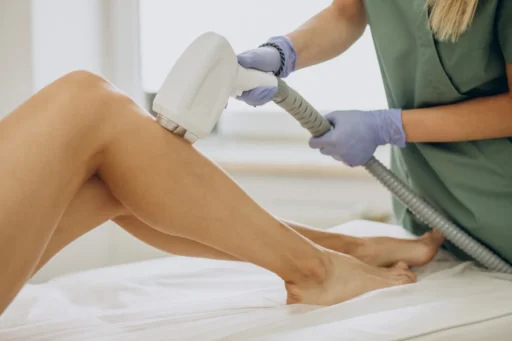For most of us, removing hair is a continuous process that we do in search of flawless skin. What if you don’t get what you were expecting the solution to be? “I regret my laser hair removal”, this statement is now becoming common with those who have tried the method.
Although laser hair removal is an option favored by many, it is not without flaws, and it is important for one to consider other treatment options.
I regret my laser hair removal
Instead of using plucked hair, electrolysis relies on electricity to destroy the follicles beneath the skin that are eventually responsible for the growth of new hair.
Nonetheless, it does not apply equally as laser can result in different results depending on various factors such as your skin color and type of hairs among others. Some individuals end up having less hair growing back, hence smoother skins, but others may be let down by these outcomes.
Reasons why one can regret their laser hair removal include high costs associated with multiple sessions; intense pain experienced during therapy and which has been likened with a slap from a rubber band; and possible side effects like irritation of the skin, redness or even burn out.
Moreover, over time some people have identified that after some years their hair will grow again, making them frustrated after investing on more permanent solutions.
Can I reverse laser hair removal?
Whether laser hair removal can be reversed or not has become a common concern among people who are questioning their decision regarding the procedure they went through.
Sadly, reversing this condition is far from simple as it would seem. The process involves damaging follicles so they cannot generate new ones anymore. Once damaged, it cannot be “fixed” to grow again.
But in most cases all follicles are not killed, hence some strands continue appearing. When regrowth happens, it’s often lighter and less coarse than before. Dissatisfied with these incomplete results or uneven hair growth, people might find alternative approaches to hair depilation.
Is it possible to remove 100% of hair with laser?
Achieving 100% hair removal through laser treatment is unlikely. Laser hair removal can significantly reduce hair growth, but it rarely eliminates every single hair.
The effectiveness of this treatment depends on various factors like the color of the hair and skin because the pigment in the hair is targeted by the laser.
Better outcomes are usually observed when there are lighter skins with darker hairs. Some individuals with fair or red or blond colored hair may find it ineffective, since their hairs have low pigmentation that can be targeted by laser.
Furthermore, hairs grow at different times, and laser treatment only affects those that are in active growth phase. This is why multiple sessions are scheduled weeks apart—to catch different hairs in the correct growth phase.
Despite undergoing numerous treatments, some follicles may be missed altogether or damaged halfway, leading to re-growth of some strands.
Alternatives to laser hair removal
For those who regret their laser hair removal or are looking for different methods, there are several alternatives to laser hair removal to consider:
Shaving
Shaving is the simplest and most popular way of getting rid of hair. It involves using a razor to slice through the hairs at skin level. This method is fast, painless and affordable, making it a common choice for both men and women.
At home, shaving can be done using just a razor with some sort of lubrication such as shaving cream or gel that will protect the skin from being cut by the razor blade, while also helping it to slip over the skin easily during shaving.
However, the results are immediate and temporary since one has to shave again after just a short time due to rapid regrowth of hair which often feels rough or bumpy to touch, thus calling for regular maintenance routines.
It should also be noted that incorrect shaving technique may lead to cuts, ingrown hairs or even razor burn.
Waxing
Waxing gets rid of hair from its root so that you can experience less regrowth time when compared to shaving, which lasts between three and six weeks. The procedure entails applying hot or cold wax onto the skin before pulling it off quickly, thereby taking away hair along with it.
Although this method might be slightly painful particularly when used in sensitive parts but as you get used more; you tend to feel uncomfortable with it more frequently.
Drawbacks include possible irritation of your skin, as well as letting your hair grow up to certain lengths necessary for effective waxing.
Sugaring
Sugaring is an ancient technique very similar to waxing but uses a natural paste or gel made from sugar, water and lemon juice among others ingredients.
When applied, this mixture is then flicked off in the direction opposite of that in which the hair grows, reducing discomfort or irritations caused by the removal process.
Sugaring pulls out hairs’ roots; however, it is considered gentler on the skin than traditional waxes. Therefore, it is suitable for people with sensitive skin. Its results can last as long as waxing.
Hair removal creams
Hair removal creams are quick and painless answers to undesirable hairs. These depilatories release chemicals, which dissolve the hairs just below the surface of the skin to make it possible to simply wipe them off after a few minutes.
This method is ideal for those who want painless alternatives to waxing or shaving, especially on large areas like legs and arms.
Additionally, these creams are effective while including moisturizing agents that improve skin moisture post-treatment.
Test your hair removal cream on a small area first before treating larger portions of your body. Hair removal creams can be a convenient and easy way of maintaining smooth skin; they are ideal for quick fixes before social events or regular grooming.
Threading
Threading is a very precise way to remove facial hair in places such as the upper lip or eyebrows. It uses a piece of twisted thread made from cotton that pulls out the hairs from their follicles.
Moreover, threading does not involve use of any chemicals, and it doesn’t pull on your skin unlike waxing and sugaring, hence making it ideal for individuals with sensitive skins be they prone to acne breakouts or not. The technique lasts up to four weeks but needs an expert because of its complexity.
Epilators
Epilators are small devices that can be held in the palm and which are able to hold many hairs at once so that they can be pulled out by them simultaneously. These may be used on different parts of the body like legs, arms and bikini area.
Epilation provides longer-lasting outcomes than shaving – typically about four weeks – as it takes out hair right from their roots.
First-time users find it hurting, mainly those having delicate skin, though it gets better after long-term usage since one becomes accustomed to the pain. A reasonable priced epilator is a good investment over time.
Electrolysis
Electrolysis is the only permanent hair removal method approved by the FDA. It involves placing a fine probe into each individual hair follicle and applying an electric current to make the follicle incapable of further hair growth. Thus, treatments must repeat themselves for all follicles during various visits.
However, electrolysis requires numerous visits per session and also demands lots of time besides being expensive even though it yields permanent results. For smaller areas like the face, this approach works best.
Natural remedies
Some prefer natural homemade remedies such as sugar, lemon, honey (similar to sugaring) or turmeric combined with gram flour for hair removal. These techniques gently treat the skin without exposing it to harsh chemicals; however, they usually eliminate less hair and do not have long-term effects.
Intense pulsed light (IPL)
IPL is often mentioned in conjunction with laser hair removal, although it uses different technology from laser machines. IPL devices emit light having a broad spectrum that targets melanin in the hair follicles.
This light energy is absorbed and converted into heat, which damages the hair follicle so that future growth is impeded.
IPL has less specificity than lasers, making it potentially unsuitable for lighter colored hairs. It can be a good option for those looking for similar outcomes as laser, but may require more treatments in order to achieve similar ends.
Each of these methods has its own positives and negatives. The choice should be guided by your type of skin, how much pain tolerance you have, budgetary considerations and how long you would like the results to last.
To get permanent results, go for electrolysis, while things like shaving or using depilatory creams offer quick fixes with little commitment required on the part of the user.
Talking over with a dermatologist or professional aesthetician will also help you make an informed choice depending on your specific needs as well as your health history.
Navigating your options
Choosing the best hair removal method can be quite difficult, especially if you have had a bad experience with laser hair removal.
Each of these methods is good at some point while poor at others, it all depends on individual needs and characteristics including skin type, hair type and pain tolerance. Knowing the pros and cons of each will lead to better decision based on personal care objectives.
Don’t forget to consult a dermatologist or professional in the aesthetic treatments field for personalized advice that suits your particular situation.
If you are moving on from laser hair removal or just beginning to consider different options, there are many choices available that can provide the desired outcome.





